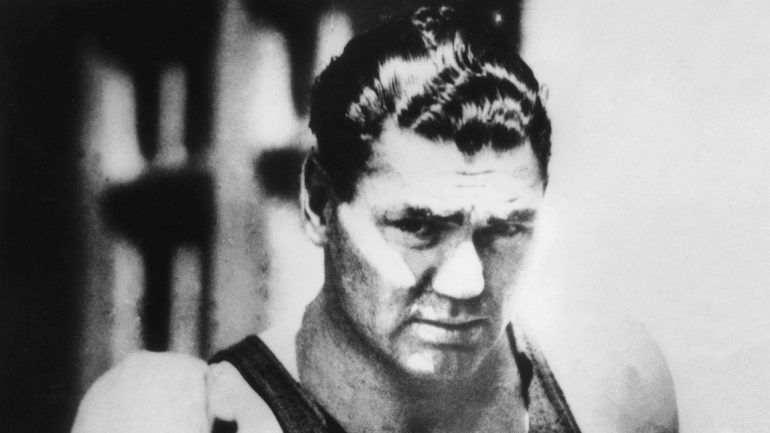10 Notable July 4 fights

2. 1910 – Jack Johnson KO 15 James J. Jeffries, Reno, Nevada
Jack Johnson was a man of his times who lived a life decades ahead of them. The first man of his race to win the heavyweight championship took great joy in infuriating the white establishment during his fights and especially between them. His three white wives – who he married within a two year span – his penchant for racing fast cars, his taunting golden-toothed smile, his braggart personality, his overly defensive fighting style and his habit of trash-talking opponents and ringsiders were too much for his critics to take. They wanted nothing more than to find someone to stop their collective pain.
In his ringside report of the Johnson-Tommy Burns fight in which “The Galveston Giant” won the title by 14th-round TKO, the New York Herald’s Jack London planted a seed by writing this final paragraph: “Only one thing remains. Jeffries must emerge from his alfalfa farm and remove that smile from Johnson’s face. Jeff, it’s up to you!”
The “Jeffries” London was referring to was James J. Jeffries, who retired as undefeated heavyweight champion four years earlier. During his prime, the burly “Boilermaker” was a formidable physical force that scored 16 knockouts in his 19 victories and held the title for five dominant years. Johnson’s foes figured if anyone could bulldoze Johnson, it was Jeffries.
At first Jeffries was hesitant. He had gained 100 pounds in the intervening years and saw no reason to take on this mantle. But over time, the talk and offers of money persuaded the old champion to change his mind. He might have recalled that in May 1902 Johnson had knocked out his brother Jack in five rounds. Whatever the cause, the first “Fight of the Century” was now a possibility, then became a certainty.
Johnson vs. Jeffries was a classic “good vs. evil” morality play, though the assigned roles were totally dependent on the beholder’s race. More than two dozen promoters submitted offers but in the end Tex Rickard’s financial heft spoke loudest. For the first time a venue was built for a single boxing show – a 20,000-seat stadium – and, because the choice of referee was so critical to both sides, Rickard offered the job to President William Howard Taft, who politely declined. Because no one else could satisfy both sides, Rickard himself ended up being the third man.
Jeffries worked himself down to a fit 227, just three pounds more than in his last fight against Jack Munroe six years earlier. An overly optimistic betting public installed Jeffries as a 10-to-7 favorite, the first time a heavyweight title challenger was so deemed.
Though the fight was scheduled for 45 rounds, it quickly became apparent that it would be Johnson who would call the shots. In the opening moments, the 32-year-old, 208-pound Johnson proved he was the physically stronger man by pinning Jeffries’ arm behind him before letting go. He also showed he was the far superior boxer, for when he chose to fight his hand speed and sharpness were far too demanding for his 35-year-old rival.
Johnson could have disposed of Jeffries quickly but he first wanted to mete out physical punishment and emotional anguish. Repeated clinches muffled any semblance of offense Jeffries could muster and during those interludes Johnson proceeded to verbally torture the ex-champ.
“Now stop lovin’ me like that, Mr. Jeff,” Johnson reportedly said in the clinches. “How do you like that jab, Mr. Jeff?” He also took time to return ringsiders’ insults with plenty of his own, a further illustration of the ease with which he was winning.
By round 15 Johnson had finished toying and was ready to get down to business. A series of slashing lefts hurt the clumsy hulk that Jeffries had become and moments later he suffered the first knockdown of his career. He hauled himself upright only to be met with a jolting 45-degree hook that sent Jeffries through the ropes. With some in the crowd shouting for the fight to be stopped to spare Jeffries – and themselves – the humiliation of a knockout defeat, others wanted the fight to go on in case their hero could conjure a miracle. Two ringsiders – one of which was a reporter – rushed to lift Jeffries back into the ring, a blatantly illegal move since a fighter must return to the ring under his own power. All it did was expose Jeffries to Johnson’s final assault, three hooks and two glancing rights that scored the third and final knockdown. The exhausted Jeffries was spared the indignity of a 10-count as his corner rushed into the ring and guided him back to his stool.
The first of what would become dozens of “Fights of the Century” had reached its end and its aftermath was particularly ugly. Race riots broke out across the nation and, depending on the source, 10 or 11 blacks were killed. The uproar led Congress to pass a ban on the transportation of fight films across state lines that lasted from 1912 to 1940.















